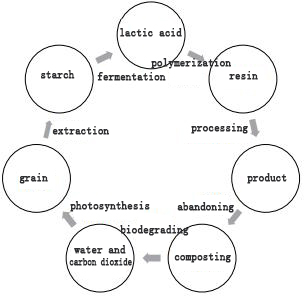1) PLA
After hydrolysis of starch to glucose, fermentation of glucose to lactic acid and polymerization of lactic acid, we can get PLA. PLA can also be processed to all kinds of products. The abandoned products can be degraded to water and carbon dioxide by recycling and composting and then absorbed by grains through photosynthesis.
The circulation procedure of PLA is shown in the following picture.

PLA is featured by high transparency, glossiness, air permeability, high modulus, complete folding, entanglement retention, low-temperature sealing, easy tearing, softness and so on. It can replace PS, PP, ABS and some other fossil plastics.
Through melt extruding, injection molding, blow molding, blistering or vacuum forming, PLA can be process to products with variable shape, such as food container (bottle or tray), packing film, wrapping film, air-permeable package, fragrance preserving package, shopping bag, rubbish bag and so on.
For example, many kinds of candies are packed by PLA. Appearance and performance of PLA film are similar to traditional candy packaging film. It is of high transparency and barrier and can preserve candy fragrance better.
PLA is also used to package food with short shelf life, such as ice cream and salad. The composite material of PLA is also used to package water, fruit juice and yogurt. These containers made from PLA can all meet standards of Germany and EU. And PLA has good biodegradable and antibacterial performance.
Tawakkal, et al, write an overview about research development of PLA as antibacterial drugs carrier. It is explained in the overview that PLA can be proper carrier for antibacterial drugs (including natural antibacterial drugs) from the perspective of mechanical and thermal properties of the mixture of antibacterial drugs and PLA. The film made from the mixture can be used as package which contact food directly to prevent bacteria. And compared with traditional fossil-based carrier (not degradable), PLA is obviously environment-friendly.
As drugs carrier, PLA is one of the few polymers approved by FDA for medical use. A hot spot in medical filed is to study sustained-release drugs which is made from PLA and prepared by 3D printing technology.
Water et al. adds furantoin into PLA and prepares sustained-release drugs through 3D printing technology. It can inhibit growth of Staphylococcus aureus.
In addition, Weisman et al. load 3D PLA with gentamicin and methotrexate. This drug delivery system can prevent infection and jaw tumor cell proliferation. This method also provides personal treatment strategy for clinical doctors. As adjustable drugs delivery system, it has great clinical prospect. Furthermore, PLA has good prospect in drugs packing field.
Ren Yiwen et al., publish a patent of PLA medical packing material and its preparation method and application. The sheet for blister packaging can be made by common plastic processing equipment after adding stablizer, plasticizer and antihydrolytic agent into PLA. This method can be applied in blister packaging for tablets to process blisters in low temperature and protect environment.
2) PHA
PHA is a kind of biopolyester particles which can be synthesized by many microorganisms. Under certain conditions, PHA content in microorganisms can reach 90% of the cells’ dry weight. Its general formula of chemical structure is as follows:

Its relative molecular mass ranges from 5*104 to 2*107. PHA also attracts people’s attention with its good biological compatibility. However, its application in material, resource and biological medicine is still limited by its poor mechanical performance, high production cost and limited functions.
In recent years, the PHA polymer after biological synthesis or chemical modification has lower production cost, better mechanical, physical and chemical performance and wider prospect in biological medicine.
Among the family of PHA, PHB has the simplest structure and widest application. It might cost 100 years to degrade traditional plastics but only 12 months for PHB and the released products of PHB degradation are water and carbon dioxide.
PHB is crystal with α - helix structure. Its crystallinity ranges from 55% to 80% and its melting point is 180 °C. It’s similar to PP in physical properties and molecular structures. Therefore, PHB is also a preferred material for green packaging. It’s widely applied in packaging razors, appliances, golf stands, baits, diapers, woman's hygiene products and cosmetics.
Different from other nanometer material, PHA have great potential as drugs carrier. Yalcin et al use PHB to package doxorubicin magnetic nanoparticles. The product can keep stable in neutral medium for 2 months and has improved anti-tumor effect.
Based on high hydrophobicity of PHB, Luo, et al synthesized low-toxic, biodegradable and temperature-sensitive amphiphilic polyurethane. Hydrophobic Docetaxel is then packaged by the micelle of polyurethane. It’s found that the nano micelle, compared with launched Docetaxel injection, can obviously increase dissolution of Docetaxel, reduce hemolytic reaction and improve blood compatibility of drugs.
3) PBS
PBS is a kind of polyester with high crystallinity. It looks milky white and is odorless and tasteless. It also has good biocompatibility and bioavailability and can be degraded to carbon dioxide and water naturally. With good mechanical performance, it is similar to PP, PE and some other universal plastics. Therefore, it suits production by different techniques of injection molding, extrusion, blowing and lamination. Besides, it can blend with calcium carbonate, starch and other filler in order to reduce cost.
If stored and used normally, PBS can have stable performance. But composted PBS will be degraded by microorganisms. PBS also has stronger heat-resistance than PLA and PHA. Its deformation temperature is close to 100°C and the figure can even exceed 100°C after modification. This means that the material can meet normal requirement for heat-resistance.
PBS is widely used in packaging (food, cosmetics, drugs and so on), tableware, disposable medical instrument, agricultural film, etc.. Recently, studies have also been widely carried out in tissue engineering, sustained-release drugs carrier and medical plastics (disposable syringe, test tube and medical catheter. PBS degrading speed is adjustable in the drugs delivery system to control drugs release speed and improve curative effect.
Pan Rui et al develop metoprolol-PBS drugs releasing system by melting-blending method and control drugs release by adding no excipients but heat treating (90°C or quenching). The result shows that drugs releasing speed of 90°C treated system is obviously quicker than that of quenched system. But in the late stage, the releasing speeds of the two systems go close to each other. It can be seen that PBS degrading system is controllable by changing heat treating technique so as to control drugs release.
4) Cellulose acetate
Cellulose acetate is made from acetyl plant cellulose and can degrade to carbon dioxide and water in natural environment. It’s an environment-friendly biodegradable plastics. Depending on degree of substitution, cellulose acetate can be divided into cellulose monoacetate, cellulose diacetate and cellulose triacetate.
Replacing hydroxyl of cellulose molecule with acetyl can alleviate function of hydrogen bond and increase space among cellulose molecules. Therefore, cellulose diacetate (or CA for short) performs well thermoplastic.

Molecular formula of CA
Properties of CA is similar to universal plastics. Its transparency is pretty good, with transmittance over 85% and conforming to requirements of transparent plastics. It is beside featured by good processability, easy film forming, outstanding hydrophilicity, large flux and high resistance to chlorine. Thanks to these features, it can be processed to all kinds of osmotic film and used to desalinate and handle water.
The commonest applications of CA are cigarette filter, tool handle, bike handle, pen holder, glass frame, container for oil or benzene, insulation material, profile and packing film... Besides, non-woven made from CA is high-level medical and hygienic material and can be used in surgical bandaging. It will not adhere to the wound.
Based on the thermoplastic property of CA, Dr. Hou Huimin, with his team integrates industrial plastic film production methods, packaging ideas and high-precision laser cutting technology and develops thermoplastic coating technology for osmotic pump tablets. This new technology consists of three steps: thermal extrusion and film forming, thermal coating and laser cutting.
Both metformin hydrochloride thermoplastic coated tablets and nifedipine thermoplastic coated tablets prepared by this new technology have zero order release characteristics of common osmotic pump controlled-release tablets. Compared with common spraying coating technology, this new technology has the following features:
A. It adopts no volatile organic solvents, generates no dust and produces thermoplastic coating film and coated tablets which will not pollute environment;
B. The coating film is prepared separately for performance control and drugs quality guarantee;
C. Coating, laser cutting and blister packaging can be finished continuously, which more suits automatic and intelligent production;
D. CA can replace PVC which is always used in blister packaging, which is more friendly to environment.
1. Prospect
The bioplastics introduced above has been widely applied in many fields. Starch plastics is mainly processed to extrusion sheet, blowing film, injection molding products, container and toys, PLA to surgical suture, orthopedic fixation materials and ophthalmic materials, PHA to biological medicines, cosmetics, opaque sheet and semi-transparent film, PBS to package for food, cosmetics and drugs, tableware, disposable medical instruments, agricultural film, sustained-release material for pesticide and fertilizer ad medical polymer materials...
In our practical production, there are also some other common plastics, including PE, PP, PVC and PET. They can be substituted by these bioplastics as follows;
Common plastics | Alternative plastics |
Name | Application in food industry and daily necessities | Application in pharmaceutical industry |
PET | Mineral water bottle, carbonated beverage bottle... | Drugs bottle | PHA, PBS, PLA |
HDPE | Cleaning products, bath products... | Infusion tube | Starch plastics, PBS |
PVC | Rarely used | Blister package | PHA, PLA, CA |
LDPE | Fresh keeping film, plastic film... | Plastic bag | Starch plastics, PBS, CA |
PP | Meal box (suitable for microwave oven) | Infusion bottle | Starch plastics, PLA, PBS |
PS | Instant noodle box, fast food box... | Drug holder, buffering material... | Starch plastics, PLA, PHA |
The table can tell us that the common plastics for inner package (bottle, blister..) and outer package (plastic bag, plastic film, drugs holder...) of drugs can all be replaced by biodegradable plastics.
As science develops, new-type bioplastics will obtain more and more functions and properties of common plastics and become more economic and practical. Besides, they can be recycled in ecosystem and generates no pollution in the form of inorganic matter. It’s a certain trend for the future drugs packaging industry to apply bioplastics and reduce and eliminate fossil-base plastics gradually.

 English
English




